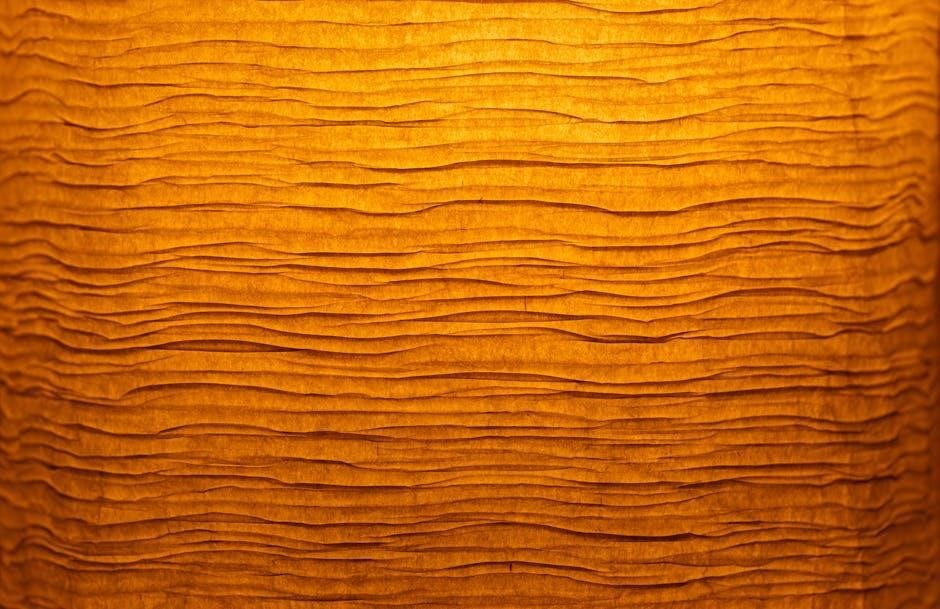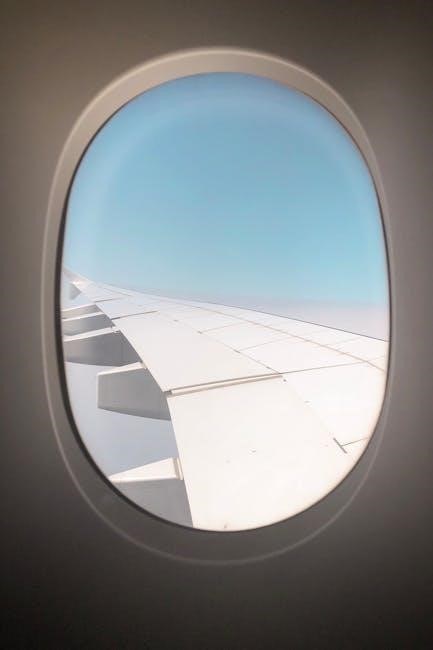Paper airplanes are a fun and educational way to explore aerodynamics and design principles. This experiment allows students to test how different designs, materials, and weights affect flight performance, making it an engaging STEM activity for learners of all ages.
1.1 Purpose of the Experiment
The purpose of this experiment is to investigate how different design elements, such as wing shape, weight distribution, and material type, affect the flight performance of paper airplanes. By testing various configurations, participants can gain insights into aerodynamic principles, including lift, thrust, and drag. This hands-on activity encourages critical thinking, problem-solving, and scientific reasoning. It also provides a fun and engaging way to explore STEM concepts, allowing participants to refine their designs based on experimental data. The ultimate goal is to determine which design achieves the longest and most consistent flight distance, while fostering creativity and analytical skills.
Materials Needed for the Experiment
The following materials are required: paper (computer, construction, card stock, notebook), scissors, markers, tape, ruler, stopwatch, and optional weights like paper clips for customization.
2.1 Types of Paper to Use
The type of paper used significantly impacts the performance of a paper airplane. Common choices include standard printer paper, construction paper, card stock, and notebook paper. Lighter papers, such as computer or notebook paper, are more aerodynamic and tend to fly farther. Heavier papers, like card stock, add durability but may reduce flight distance. Colored or patterned papers can enhance creativity, while textured or recycled papers offer unique challenges. The thickness and flexibility of the paper influence how well it holds its shape during flight. Experimenting with different paper types allows participants to observe variations in aerodynamics and stability, making it a key variable in the experiment.
2.2 Additional Materials for Customization
Beyond paper, various materials can enhance or modify a paper airplane’s performance. Adding paper clips or small weights to the nose or wings allows experimentation with weight distribution. Clear tape or glue can reinforce folds and improve durability. Markers or colored pencils enable customization for visibility or aesthetics. Staples or small tabs can alter aerodynamics by creating texture or changing airflow. These materials provide opportunities to test how modifications affect flight distance, stability, and overall performance, encouraging creative problem-solving and hands-on learning. Each addition offers a unique variable to explore, enriching the experiment’s scope and educational value.

Scientific Principles Behind Flight
Flight relies on lift, thrust, drag, and weight. Lift is generated by wing shape, thrust by forward motion, while drag and weight counteract these forces, affecting performance.
3.1 Lift and Its Importance
Lift is the upward force that opposes weight and enables flight. In paper airplanes, lift is generated by the wings, which are designed to produce a difference in air pressure above and below. According to Bernoulli’s Principle, faster-moving air creates lower pressure, so the curved upper surface of the wing accelerates air, reducing pressure and creating lift. The angle of attack and wing shape significantly influence lift generation. A well-designed wing with a smooth surface and proper curvature maximizes lift, allowing the plane to soar farther. Understanding lift is crucial for optimizing paper airplane designs and improving their aerodynamic performance during experiments.
3.2 Thrust and Drag Forces
Thrust is the forward force propelling the paper airplane, typically generated by the initial throw. Drag, or air resistance, opposes thrust, slowing the plane down. Streamlined designs reduce drag, enhancing flight distance. Wing shape and weight distribution significantly impact drag, with lighter planes generally experiencing less resistance. Experimenting with nose design and wing angles can improve thrust efficiency. Balancing thrust and drag is key to achieving optimal flight performance in paper airplanes, making it a critical factor in aerodynamic experiments. Understanding these forces helps refine designs for better results, aligning with principles of aerodynamics and engineering.
3.4 Weight Distribution in Paper Airplanes
Weight distribution significantly affects a paper airplane’s flight performance. A heavier nose improves stability and distance, while a lighter tail increases maneuverability. Adding materials like paper clips can test weight effects. Proper balance prevents stalling or diving, ensuring smoother flights. Experiments show optimal distribution enhances aerodynamics, making it vital for design refinement. This principle, rooted in physics, helps students understand how mass allocation impacts motion, aligning with broader engineering concepts. By adjusting weights, flyers can customize their planes for specific flight characteristics, demonstrating the importance of balance in aerodynamic design. This hands-on learning aids in grasping fundamental scientific principles through practical application and observation. Always test variations to identify ideal configurations for desired flight outcomes, ensuring each modification is documented for accurate analysis and comparison. Understanding weight distribution’s role is essential for optimizing paper airplane performance and achieving consistent, successful flights.

Design Variations and Their Impact
Design variations, such as wing shape and nose structure, significantly influence flight performance. Different designs can enhance aerodynamics, stability, and distance, offering unique advantages for specific flight goals.
4.1 Basic vs. Advanced Designs
Basic designs, like simple folds, are easy to create and provide a foundational understanding of flight mechanics. Advanced designs incorporate intricate folds, such as angled wings or weighted noses, to improve aerodynamics and stability. These variations allow for longer flights and better performance. By comparing basic and advanced models, experimenters can identify how specific design elements impact flight distance and behavior. This comparison helps in refining designs and understanding the principles behind successful paper airplane construction, making it a valuable step in the experimental process.
4.2 Influence of Wing Shape on Aerodynamics
The shape of a paper airplane’s wings significantly impacts its aerodynamic performance. Curved or angled wings can enhance lift by directing air downward, creating pressure differences. Wider wings increase surface area, improving stability, while narrower wings reduce drag for faster flights. Experimental variations, such as adding flaps or winglets, can further refine aerodynamic efficiency. Testing different wing designs helps determine which shape maximizes flight distance and stability. This exploration highlights how subtle changes in wing structure can dramatically affect a paper airplane’s overall performance, making it a key focus in aerodynamic studies.
4.3 Effect of Nose Design on Flight Performance
The design of a paper airplane’s nose plays a crucial role in its flight performance. A rounded or pointed nose can reduce air resistance, improving aerodynamics. Folding the nose to create a heavier front increases stability but may reduce glide distance. Experimenting with different nose shapes, such as angled or curved designs, can enhance lift and control. Small adjustments to the nose’s weight distribution significantly impact how the plane behaves in flight, making it a key factor in optimizing performance. This experimentation helps understand how subtle changes in design can influence aerodynamic efficiency and overall flight characteristics.
Conducting the Experiment
Set up a controlled environment, ensure consistent launches, and measure flight distances accurately. Record data in a table, minimizing variables like wind to ensure reliable results.
5.1 Setting Up the Experiment
To set up the experiment, begin by selecting a large, open space with minimal wind interference, such as a hallway or indoor stadium. Gather all materials, including paper, tape, scissors, and weights like paper clips. Ensure consistent testing conditions by marking a fixed launch point and using the same throwing technique for each trial. Prepare several paper airplane designs with variations in wing shape, nose design, and weight distribution. Before each test, record the design specifications and any modifications. Use a data table to document flight distances, stability, and other observations. This setup allows for a systematic comparison of how design changes impact aerodynamic performance.
5.2 Variables to Test and Measure
Key variables to test include the type of paper, weight distribution, wing shape, and nose design. Measure flight distance, stability, and aerodynamic performance. Conduct multiple trials for accuracy and consistency. Record data on how design changes affect lift, thrust, and drag. Use a controlled environment to minimize external factors. Ensure each modification is isolated to clearly identify its impact. This systematic approach helps determine which design elements contribute most to flight success. By focusing on specific variables, the experiment provides insights into optimizing paper airplane performance for distance and stability.
5.3 Recording and Analyzing Data
Record flight distance, wingspan, and weight distribution for each design. Use a table to track multiple trials, ensuring accuracy and consistency. Measure flight time and note any stability issues. Analyze data to identify trends, such as how wing shape or nose design affects performance. Compare results to determine which variables yield the best flight outcomes. Discuss any inconsistencies and their possible causes. Use graphs or charts to visualize findings, making it easier to draw conclusions; Ensure all data is clear and organized for further interpretation and refinement of designs. This step is crucial for understanding the impact of design changes on flight performance.

Results and Conclusion
The experiment revealed that specific designs, such as those with streamlined noses and balanced weight distribution, achieved the longest flight distances. These findings highlight the importance of aerodynamic design in optimizing flight performance, offering practical insights for further engineering explorations.
6.1 Interpreting the Results
By analyzing the flight data, it became clear that specific design elements significantly impacted performance. Planes with streamlined noses and balanced weight distribution consistently flew farther, demonstrating the importance of aerodynamic principles. Variations in wing shape and material type also influenced flight distance, with sturdier papers and wider wings often yielding better results. The data highlighted how small modifications, such as adding weight or adjusting folds, could enhance stability and distance. These findings underscored the role of trial and error in optimizing designs, providing a foundation for further experimentation and refinement of paper airplane aerodynamics.
6.2 Drawing Conclusions
The experiment demonstrated that design and material choices significantly affect paper airplane performance. Planes with optimized weight distribution, streamlined noses, and wider wings consistently flew farther, highlighting the importance of aerodynamic principles. The data supported the hypothesis that modifications, such as wing shape and added weight, could enhance flight distance and stability. These findings validate the role of iterative testing in refining designs. By applying scientific reasoning and engineering principles, participants can create more efficient paper airplanes. The results encourage further experimentation to explore additional design variations and their impact on flight dynamics, fostering a deeper understanding of aerodynamics through hands-on learning.
6;3 Possible Improvements
Future experiments could benefit from controlling environmental factors like wind and air resistance by conducting tests indoors. Incorporating additional measurements, such as flight time and stability, would provide a more comprehensive analysis. Testing a wider variety of materials, including different weights and textures of paper, could reveal new insights. Exploring advanced designs, such as flaps or curved wings, might enhance performance. Increasing the number of trials per design would improve data reliability. Additionally, involving a larger group of participants could offer diverse perspectives and techniques, potentially uncovering innovative design approaches. These modifications would refine the experiment and deepen understanding of aerodynamic principles.
Appendix
Includes a sample PDF template for documenting experiments, data tables, and additional resources for further exploration of paper airplane design and aerodynamics principles.
7.1 Sample PDF Template
A sample PDF template for the paper airplane experiment includes sections for materials, design variations, and data collection. It provides a structured format for recording flight distances, times, and observations. The template often features tables for comparing different designs, such as wingspan measurements and weight distribution tests. Additionally, it may include space for sketches of airplane designs and notes on environmental factors like wind conditions. This template helps ensure consistency and organization in documenting the experiment, making it easier to analyze results and draw conclusions. It’s a valuable tool for both students and educators to track progress and refine designs effectively.

Resources for Further Reading
For those interested in diving deeper, several resources offer detailed guides and templates for paper airplane experiments. The RAF Museum provides comprehensive instructions and data tables for tracking flight performance. STEM education websites feature downloadable PDF templates for documenting experiments. Additionally, YouTube channels like “How to make a paper airplane” offer step-by-step tutorials and design inspiration. Academic papers from institutions like New York University explore the aerodynamics behind paper flight. These resources provide a wealth of information for educators, students, and enthusiasts looking to enhance their understanding and improve their paper airplane designs. They are invaluable for both classroom activities and independent study.
